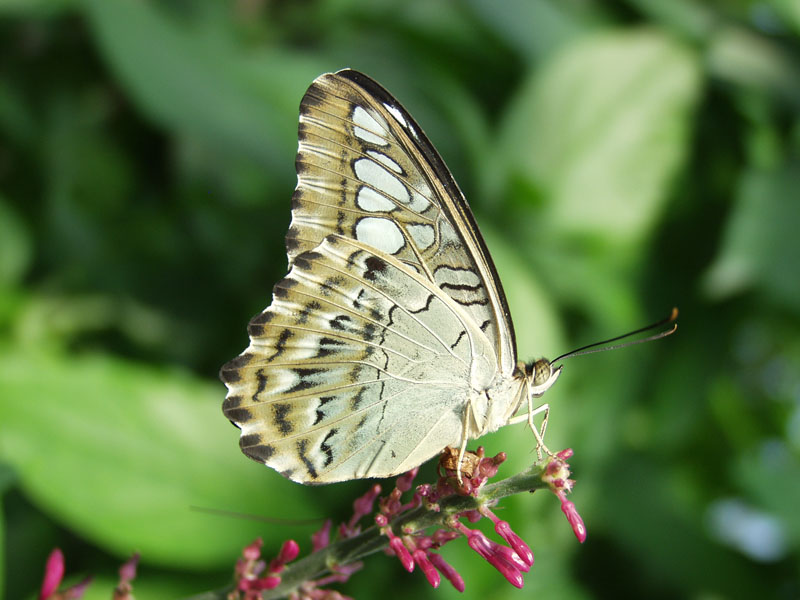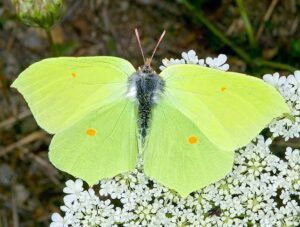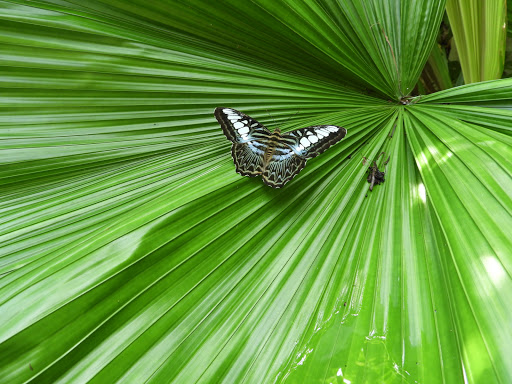
Common Name: Blue Clipper
Scientific Name: Parthenos sylvia lilacinus
Wingspan: 8.5-9.0 cm
Location: Commonly found in South Thailand and Malaysia
The Blue Clipper is a member of the Nymphalidae family and it prefers the plain areas and forest edge. The color of the forewing dorsum and hindwing basal are a brilliant lilac blue colour.
Blue Clipper butterfly
Commonly found in South Thailand and Malaysia.
The Blue Clipper is a member of the Nymphalidae family and it prefers the plain areas and forest edge. The colour of the forewing dorsum and hindwing basal are a brilliant lilac blue colour.
Parthenos sylvia, the clipper, is a species of nymphalid butterfly found in south and southeast Asia, mostly in forested areas.The clipper is a fast-flying butterfly and has a habit of flying with its wings flapping stiffly between the horizontal position and a few degrees below the horizontal. It may glide between spurts of flapping.
Did you know?
The Blue Clipper is fast flying and has a wingspan of 85 – 90mm!
Description:
is a large (wingspan: 48 – 75mm) butterfly in the family Nymphalidae, found in forested areas of south and southeast Asia. A powerful and fast flyer, it alternates between periods of rapid wing flapping and gliding. Parthenos sylvia comprises a remarkable number of subspecies which show completely different base colors. The subspecies seen here, P. p. lilacinus or Blue Clipper, is found in Thailand and Peninsular Malaysia (Daniele Pralong description)
Male. Wings large, broad. Forewing triangular; costa very slightly curved, apex rounded, exterior margin oblique and slightly scalloped, posterior margin short, angle convex; costal vein extending to two-thirds of the costal margin, free from the subcostal in both sexes; first and second subcostal branches somewhat undulated, the first subcostal emitted before one-half length of the cell, second at one-sixth before the end, third at half length beyond the cell and curved upward, running close along second for some distance and ending at the apex, fourth and fifth on a short footstalk starting from near base of the third; cell long, narrow; upper discocellular extremely short, bent immediately below the subcostal, middle discocellular inwardly oblique and straight, lower discocellular concave and directed inward, radials from the upper and lower angles;
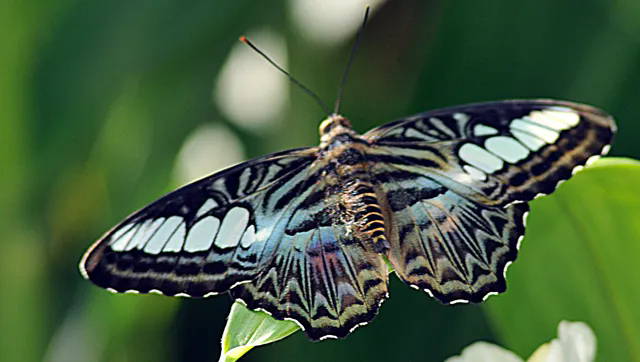
upper median veinlet bent convexly upward beyond the cell and then extending parallel and at equal distance with lower branches, middle branch emitted before end of the cell, lower branch at a considerable distance before its end; submedian recurved near its base.
Hindwing short, very broad, somewhat quadrate; exterior margin scalloped, produced outward below the middle; costal vein much arched from the base and extending to the apex; precostal vein distinct, extending parallel with and joined to the costal — thus forming a closed precostal cell — and there throwing off a short bifid spur, towards the costa, immediately before its junction with the costal vein; cell very short; first and second subcostal branches emitted at about equal distances from upper base of cell; upper and lower discocellulars outwardly-oblique, each slightly concave, lower discocellular slender, radial from their middle; two upper median branches emitted from end of the cell, upper bent convexly near its base, lower from one-third before end of the cell; submedian curved near the base; internal vein straight, short.
Body stout, abdomen short; palpi ascending, pilose beneath and above at tip of second joint; second joint very long, extending to a level with vertex, third joint very short, pointed; legs slender, long; antennae long, gradually thickened towards the tip. Eyes naked. Sexes alike.
Food Source
Adults will feed from a variety of flowers but they tend to prefer smaller flowers which makes Lantana one of their favorite nectar sources.
Etymology Of Name
The genus Parthenos is Greek for virgin. The specie sylvia comes from the Latin word silva which means “wood or forest”.
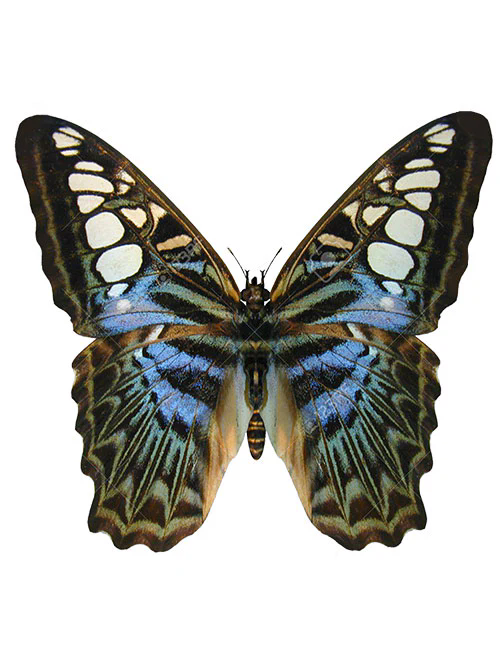
Habitat
The adults prefer open country sides but they can often be found flying through the tropical forest especially along the rivers and streams.
Life history
Adult Clippers are fairly strong flyers so it is possible for them to cover a fair amount of ground each day. After mating the females lay their eggs on the host plant. The colorful larva feeds on the host plant until it forms its chrysalis.
Clipper butterfly (Parthenos sylvia) in the exhibit
The Parthenos sylvia, or the Clipper, is a butterfly usually found in the rainforests of South and Southeast Asia. They have large wings that make them strong fliers and gliders. Although they have similar markings, there are more than 30 subspecies that have visual differences and live in different regions.
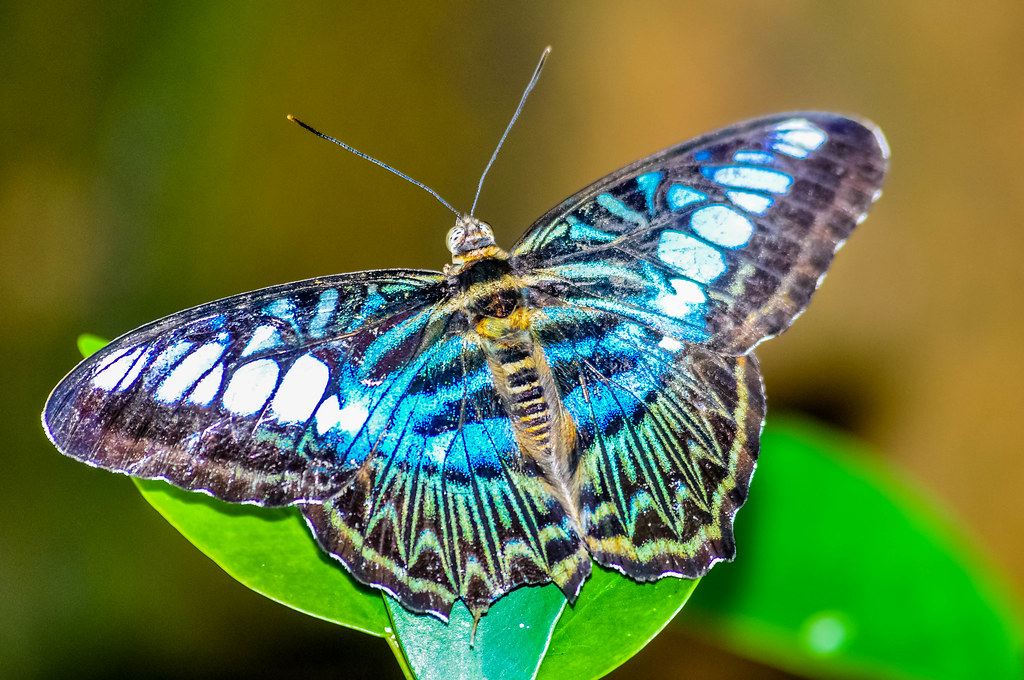
Flights
There are multiple generations each year making it possible to find adults throughout the year with the highest populations found from December through February.
Fun Facts
The Clipper butterfly can be found in a variety of different colors such as blue, green, brown and gold. Each of these different color forms is considered to be a subspecie of Parthenos sylvia. The current understanding is a single population was separated by the formation of mountains and islands, which allowed the different colors to evolve in a particular area.
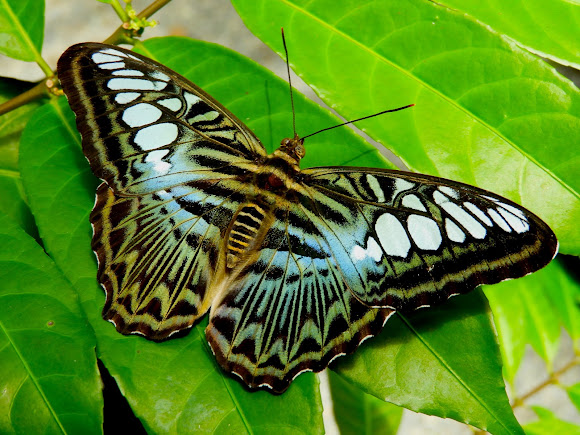
THE CLIPPER, PARTHENOS SYLVIA
The Clipper occurs in a wide distribution across South and Southeast Asia. The dorsal wing surface is mainly black, with distinctive stripes crossing over the body and streaks along the bottom hindwing edges. The forewings contain a row of large, white cells, while fewer and smaller white spots are found on the upper edge of the hindwing. Towards the body, the wing colour depends on the form: Cambridge Butterfly Conservatory exhibits both a blue and brown Clipper colour form.
Clippers are found in rainforests, often near rivers. They have a shallow and rapid flight that alternates with periods of gliding. Clipper caterpillars are reddish-brown speckled with white, and each body segment has four purplish-red spines. Pupation occurs in light green to olive chrysalids hung from the underside of leaves. Caterpillars feed on Passionflowers (Adenia sp.) and herbaceous vines (Tinospora sp.), whereas adults nectar from Verbena (Lantana sp.) and other flowers.

